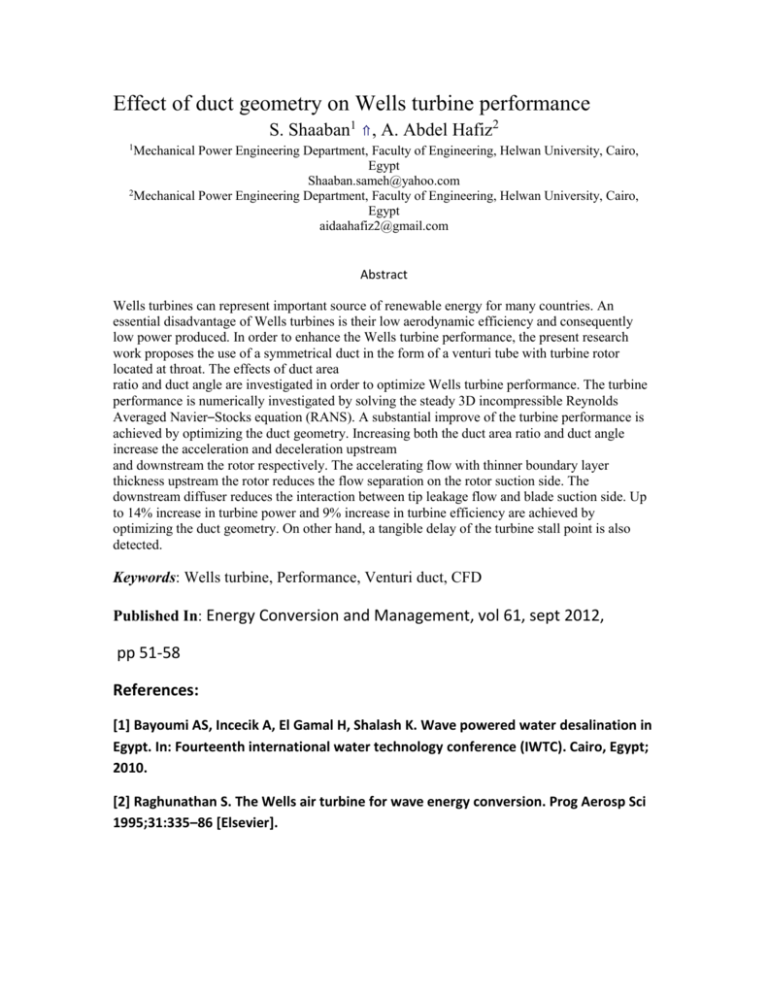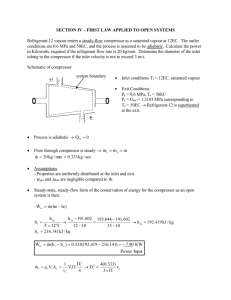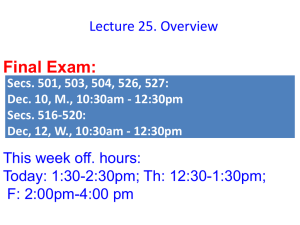Book_of_abstract
advertisement

Effect of duct geometry on Wells turbine performance S. Shaaban1 ⇑, A. Abdel Hafiz2 1 Mechanical Power Engineering Department, Faculty of Engineering, Helwan University, Cairo, Egypt Shaaban.sameh@yahoo.com 2Mechanical Power Engineering Department, Faculty of Engineering, Helwan University, Cairo, Egypt aidaahafiz2@gmail.com Abstract Wells turbines can represent important source of renewable energy for many countries. An essential disadvantage of Wells turbines is their low aerodynamic efficiency and consequently low power produced. In order to enhance the Wells turbine performance, the present research work proposes the use of a symmetrical duct in the form of a venturi tube with turbine rotor located at throat. The effects of duct area ratio and duct angle are investigated in order to optimize Wells turbine performance. The turbine performance is numerically investigated by solving the steady 3D incompressible Reynolds Averaged Navier–Stocks equation (RANS). A substantial improve of the turbine performance is achieved by optimizing the duct geometry. Increasing both the duct area ratio and duct angle increase the acceleration and deceleration upstream and downstream the rotor respectively. The accelerating flow with thinner boundary layer thickness upstream the rotor reduces the flow separation on the rotor suction side. The downstream diffuser reduces the interaction between tip leakage flow and blade suction side. Up to 14% increase in turbine power and 9% increase in turbine efficiency are achieved by optimizing the duct geometry. On other hand, a tangible delay of the turbine stall point is also detected. Keywords: Wells turbine, Performance, Venturi duct, CFD Published In: Energy Conversion and Management, vol 61, sept 2012, pp 51-58 References: [1] Bayoumi AS, Incecik A, El Gamal H, Shalash K. Wave powered water desalination in Egypt. In: Fourteenth international water technology conference (IWTC). Cairo, Egypt; 2010. [2] Raghunathan S. The Wells air turbine for wave energy conversion. Prog Aerosp Sci 1995;31:335–86 [Elsevier]. [3] Thomas Gareth. The theory behind the conversion of ocean wave energy: a review. In: Cruz Joمo, editor. Ocean wave energy: current status and future perspectives. Berlin Heidelberg: Springer; 2008. p. 41–91. [4] Bent Sّrensen. Renewable energy conversion, transmission and storage. Elsevier; 2007. [5] Gato LMC, Warfield V, Thakker A. Performance of a high-solidity Wells turbine for an OWC wave power plant. Trans ASME J Energy Resour Technol 1996;118:263–86. [6] Curran R, Gato LMC. The energy conversion performance of several types of Wells turbine designs. Proc Inst Mech Eng 1996;211(2):133–45. [7] Kim TH, Setoguchi T, Kaneko K, Raghunathan S. Numerical investigation on the effect of blade sweep on the performance of Wells turbine. Renew Energy 2002;25:235–48 [Elsevier]. [8] Brito-Melo A, Gato LMC, Sarmento AJNA. Analysis of Wells turbine design parameters by numerical simulation of the OWC performance. Ocean Eng 2002;29:1463–77 [Elsevier]. [9] Dhanasekaran TS, Govardhan M. Computational analysis of performance and flow investigation on well turbine for wave energy conversion. Renew Energy 2005;30:2129–47 [Elsevier]. [10] Setoguchi T, Takao M, Kaneko K. A comparison of performances of turbines for wave power conversion. Int J Rot Mach 2000;6(2):129–34. [11] Setoguchi T, Takao M. Current status of self rectifying air turbines for wave energy conversion. Energy Convers Manag 2006;47:2382–96. [12] Raghunathan S, Setoguchi T, Kaneko K. The effect of inlet conditions on the performance of Wells turbine. J Energy Resour Technol 1989;111:37–42. [13] Kim T, Setoguchi T, Kinoue Y, Kaneko K. Effects of blade geometry on performance of Wells turbine for wave power conversion. J Therm Sci 2001;10(4). [14] Setoguchi T, Santhakumar S, Takao M, Kim TH, Kaneko K. A modified wells turbine for wave energy conversion. Renew Energy 2003;28:79–91. [15] Takao M, Setoguchi T, Kinoue Y, Kaneko K. Effect of end plates on the performance of a Wells turbine for wave energy conversion. J Therm Sci 2006;15(4):319–23. [16] Torresi M, Camporeale SM, Strippoli PD, Pascazio G. Accurate numerical simulation of a high solidity wells turbine. Renew Energy 2008;33:735–47. [17] Setoguchi T, Santhakumar S, Takao M, Kim TH, Kaneko K. Effect of guide vane shape on the performance of a wells turbine. Renew Energy 2001;23:1–15. [18] Govardhan M, Dhanasekaran TS. Effect of guide vanes on the performance of a variable chord self-rectifying air turbine. J Therm Sci 1998;7(4). [19] Taha Z, Sugiyono Sawada T. A comparison of computational and experimental results of wells turbine performance for wave energy conversion. Appl Ocean Res 2010;32:83–90. [20] Taha Z, Sugiyono TMYS, Ya T, Swada T. Numerical investigation on the performance of Wells turbine with non-uniform tip clearance for wave energy conversion. Appl Ocean Res 2011;33:321–31. [21] Suzuki M. Design method of guide vane for wells turbine. J Therm Sci 2005;15(2). [22] Govardhan M, Dhanasekaran TS. Effect of guide vanes on the performance of a self-rectifying air turbine with constant and variable chord rotors. Renew Energy 2002;26:201–19. [23] Dixon SL. Fluid mechanics and thermodynamics of turbomachinery. 5th Ed. Elsevier; 1998. [24] Torresi M, Camporeale SM, Pascazio G, Fortunato B. Fluid dynamic analysis of a low solidity wells turbine. In: 59_ Congresso ATI. Genova, Italy; 2004. [25] Hansen MOL, Sّrensen JN, Voutsinas S, Sّrensen N, Madsen HA. State of the art in wind turbine aerodynamics and aeroelasticity. Progr Aerosp Sci 2006;42:285–330 [Elsevier]. [26] Gareev A. Analysis of variable pitch air turbines for oscillating water column (OWC) wave energy converters. PhD thesis, University of Wollongong. School of Mechanical, Materials and Mechatronic Engineering, University of Wollongong, 2011. [27] Dufour G, Gourdain N, Duchaine F, Vermorel O, Gicquel LYM, Boussuge JF, Poinsot T. Numerical investigations in turbomachinery: a state of the art. VKI Lect Ser 2009. [28] Carcangiu CE. CFD-RANS study of horizontal axis wind turbines. PhD Thesis. Università degli Studi di Cagliari, Italy; 2008. [29] Gareev A, Cooper P, Kosasih PB. CFD analysis of air turbines as power take-off systems in oscillating water column wave energy conversion plant. In: Proceedings of the 8th European wave and tidal energy conference. Uppsala, Sweden; 2009. [30] Falcمo AF de O, Justino PAP. OWC wave energy devices with air flow control. Ocean Eng 1999;26:1275–95. [31] Falcمo AF de O. Control of an oscillating-water-column wave power plant for maximum energy production. Appl Ocean Res 2002;24:73–82. [32] Rao SS, Murthy BK. A new control strategy for tracking peak power in a wind or wave energy system. Renew Energy 2009;34:1560–6. [33] Amundarain M, Alberdi M, Garrido AJ, Garrido I, Maseda J. Wave energy plants: control strategies for avoiding the stalling behaviour in the Wells turbine. Renew Energy 2010;35:2639–48. [34] Govardhan M, Chauhan VS. Numerical studies on performance improvement of self-rectifying air turbine for wave energy conversion. Eng Appl Comput Fluid Mech 2007;1(1):57–70 Effect of inlet straighteners on centrifugal fan performance 1N.N. 1 Bayomi , 1A. Abdel Hafiz and 2A.M. Osman Faculty of Engineering, Mataria, Helwan University, 11718 Masaken, El-Helmia, Cairo, Egypt aidaahafiz2@gmail.com nnbayomi@hotmail.com Faculty of Engineering, Shoubra, Zagazig University, Cairo, Egypt Received 31 July 2005; accepted 30 January 2006. Available online 3 April 2006. 2 Abstract The use of straighteners in the inlet duct of centrifugal fans is suggested for eliminating any inlet distortion. An experimental investigation was performed to study the effect of inlet straighteners on the performance characteristics of centrifugal fans. Two types of straighteners were used, circular tubes and zigzag cross section, with different lengths. Circular tubes with different diameters have been investigated. The study was conducted on three types of fans, namely radial, backward with exit blade angles 60° and 75° and forward with 105° and 120°. The results confirm that the inlet straighteners exhibit different effects on the fan performance for the different blade angles. Accordingly, the results indicate the selection of long circular tube straighteners with large diameter for radial blades, long zigzag type for backward 60° blade angle and short zigzag type for backward 75° blade angle. Generally, good improvements in efficiency are observed for radial and backward blades on account of a slight drop in static head. In addition, an increase in the flow margin up to 12% and a decrease in the noise level from 3 to 5 dB are indicated compared to the free inlet condition. On the contrary, unfavorable influences are exerted on the forward fan performance. Keywords: Centrifugal fan; Straighteners; Noise; Distortion Published in: Energy Conversion and Management, Vol. 47, Issues 18-19, Nov. 2006, Pages 3307-3318 References [1] Ariga I, Kasai N, Masuda S, Watanabe Y, Watanabe I. The effect of inlet distortion on the performance characteristics of a centrifugal compressor. Trans ASME, J Eng Power 1983;105:223–30. [2] Ariga I, Masuda S, Okita A. Inducer stall in a centrifugal compressor with inlet distortion. ASME paper 86-GT-139, 1986. [3] Graber EJ, Braithwaite WM. Summary of recent investigations of inlet distortion effects on engine stability. AIAA paper no. 74-236, 1974. [4] Greitzer EEM. The stability of pumping systems. Trans ASME, J Fluid Eng 1981;103:193–242. [5] Baghdadi S, Lueke JE. Compressor stability analysis. Trans ASME, J Fluid Eng 1982;104:242–9. [6] Wright T, Madhavan S, Di Re J. Centrifugal fan performance with distorted inflows. Trans ASME, J Eng Gas Turb Power 1984;106(October):895–900. [7] Madhavan S, Wright T. Rotating stall caused by pressure surface flow separation on centrifugal fan blades. ASME paper 84-GT-35, 1984. [8] Madhavan S, Wright T. Rotating stall caused by pressure surface flow separation on centrifugal fan blades. Trans ASME, J Eng Gas Turb Power 1985;107(July):775–81. [9] Chen P, Soundra-Nayagam M, Bolton AN, Simpson HC. Unstable flow in centrifugal fans. Trans ASME, J Fluids Eng 1996; 118(March):128–33. [10] Montazerin N, Damangir A, Mirian S. A new concept for squirrel-cage fan inlet. Proc Instn Mech Eng 1998;212(Part A):343–9. [11] Kassens L, Rautenberg M. Flow measurements behind the inlet guide vane of a centrifugal compressor. ASME paper 98-GT-86, 1998. [12] Coppinger M, Swain E. Performance prediction of an industrial centrifugal compressor inlet guide vane system. IMechE, Part A 2000;214:153–64. [13] Jack BE. Fan selection and to reduce inefficiency and low frequency noise generation. In: Fan noise 2003, International symposium Senlis, 23–25 September. [14] Bhope DV, Padole PM. Experimental and theoretical analysis of stresses, noise and flow in centrifugal fan impeller. Mech Mach Theory 2004;39(12):1257–71. [15] Liberman MYu. Investigation of noise characteristics for centrifugal ship fans. In: XI session of the Russian acoustical society, Moscow, November 19–23, 2001. p. 572–5. [16] Cumpsty NA. Compressor aerodynamics. New York: John Wiley and Sons, Inc.; 1989

